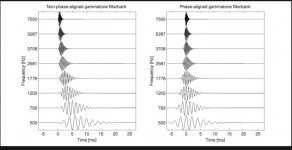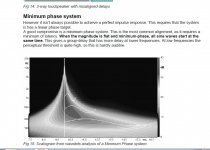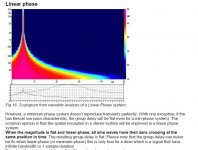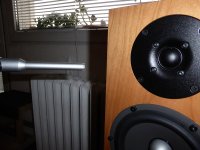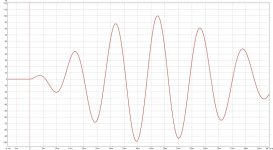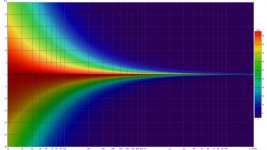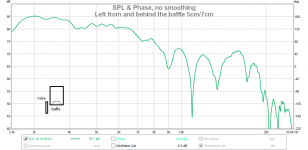When we're talking about how diffraction affects imaging, I wonder if it's the temporal issues that degrade imaging, or the amplitude response variations with small lateral head-movements.
In listening environments with walls and ceiling, lots of inconsistent radiation off-axis (as from comb-filtering or standing waves) adds a lot of load to the regions of the brain that relate sound with 3D space. That can take as much brain power as protecting a lie.
Afaik the brain makes sense of frequency response variations in both time and space and this affects imaging and coloration.
So whether you're dealing with "coloration" or early reflections or diffraction it all comes down to interpreting frequency response variations.
I've been wondering if there is an audio equivalent to the random-dot stereograms of Bela Julesz?Lidia and I just recently completed a study of room reflections on image localization...
Random dot stereogram - Wikipedia
B.
bent o'ronto you shouldn't toke and text or can you explain your thinking on this one a little more clearly?
Julesz (an acquaintance at Bell Labs) produced spatial localization without a visual object (at least in the usual sense). Can we produce at least azimuth localization using prepared random noise?... your thinking on this one a little more clearly?
It would be a test paradigm a lot better than some of the remarkable hearing claims in this thread.
B.
one guy says : I am talking about imaging and how diffraction degrades it.
the other guy says: it's coloration.
maybe it's the scotch, but i thought they where talking about the same thing but using different names/labels...?
the other guy says: it's coloration.
maybe it's the scotch, but i thought they where talking about the same thing but using different names/labels...?
one guy says : I am talking about imaging and how diffraction degrades it.
the other guy says: it's coloration.
Whatever you call it, one critical factor seems to go missing in this discussion: it isn't the performance of a speaker we are talking about, it is the difference between the speakers' outputs that creates location. If both have similar diffraction, then diffraction has no meaningful first-order effect on localization.
(I'm sure somebody will riff on some second-order differential wall reflections phantasy about why diffraction really is so important.)
B.
As opposed to what stereo ideally does? Stereo will pinpoint image (at the very least) and by that I mean without fatigue.spatial localization without a visual object (at least in the usual sense).
Some interesting approaches to minimizing baffle diffraction:
https://www.diyaudio.com/forums/ful...rmance-speaker-enclosures-36.html#post5572691
https://www.diyaudio.com/forums/ful...rmance-speaker-enclosures-36.html#post5572691
Whatever you call it, one critical factor seems to go missing in this discussion: it isn't the performance of a speaker we are talking about, it is the difference between the speakers' outputs that creates location. If both have similar diffraction, then diffraction has no meaningful first-order effect on localization.
(I'm sure somebody will riff on some second-order differential wall reflections phantasy about why diffraction really is so important.)
B.
Well I'm not sure I agree with this simplification. In my book diffraction of the enclosure makes it easier to spot the speaker position itself, that doesn't mean it can't project or produce a phantom image.
Less diffraction seems to help a great deal to help make the speakers "disappear".
I think the valuable information I take away from this discussion is in what was said in reply to
Diffraction IMO is simply another form of early reflection.
Which was:
They are very similar and yet fundamentally different. Both can be thought of as creating image sources. In a reflection the virtual image is exactly that of a mirror - some distance behind the reflector. On the other hand, diffraction results from a boundary change and it too creates a virtual image source, but positioned exactly at the diffraction point (or line or whatever.) Hence diffraction will always be much closer in time to the direct sound than a reflection will. A very significant difference.
That part explains why diffraction points out the speaker position, while for instance an early side wall reflection can seem to widen the perceived imaging. Reduce both and imaging gets more defined.
Hi all, a graph from this thread haunts me.....
I think it's all wrong...
I think for any waveform origination, phase alignment is when initial rise times are in sync....not peak energies.
And if that understanding is true, and IF our hearing is in sync with true waveform origination, graph must be back-asswards....????
Please straighten my thinking....
I think it's all wrong...
I think for any waveform origination, phase alignment is when initial rise times are in sync....not peak energies.
And if that understanding is true, and IF our hearing is in sync with true waveform origination, graph must be back-asswards....????
Please straighten my thinking....
Attachments
I think that your definition of "phase alignment" and the graphs must be different. I didn't know exactly what was meant by the term when I read it, so IO just ignored that part of the plot.
Afaik the brain makes sense of frequency response variations in both time and space ...
"and space"? How does the ear, which is fixed in space, do that exactly?
Hi all, a graph from this thread haunts me.....
I think it's all wrong...
I think for any waveform origination, phase alignment is when initial rise times are in sync....not peak energies.
And if that understanding is true, and IF our hearing is in sync with true waveform origination, graph must be back-asswards....????
Please straighten my thinking....
I think you're talking about the difference between a minimum phase system and a linear phase system ?
I took these grabs from 'delay alignment a survey' pdf I found online.
Attachments
On the other hand, diffraction results from a boundary change and it too creates a virtual image source, but positioned exactly at the diffraction point (or line or whatever.).
Would it be possible to investigate these virtual image sources by a microphone placed near to baffle edge line as shown in the attached photo? If yes, what is the interpretation of the plot shown, measured this way. Thank you.
Attachments
Questions about diffraction audibility.
Localisation.
I just did an experiment where I was blindfolded and my kid was standing in random places in the room making a noise, and I was able to pinpoint his location very accurately even when standing right next to a corner, cabinet or couch. Shouldn't it be more difficult to pinpoint the location of a sound when close to a corner? This didn't seem to happen, but I'm not sure. Maybe others can do something similar and post their results.
When listening to square boxes, sounds seem all to have the same size. A small speaker, everything sounds small. A big speaker, everything sounds big. Is this due to diffraction?
Localisation.
I just did an experiment where I was blindfolded and my kid was standing in random places in the room making a noise, and I was able to pinpoint his location very accurately even when standing right next to a corner, cabinet or couch. Shouldn't it be more difficult to pinpoint the location of a sound when close to a corner? This didn't seem to happen, but I'm not sure. Maybe others can do something similar and post their results.
When listening to square boxes, sounds seem all to have the same size. A small speaker, everything sounds small. A big speaker, everything sounds big. Is this due to diffraction?
Hi all, a graph from this thread haunts me.....
I think it's all wrong...
I think for any waveform origination, phase alignment is when initial rise times are in sync....not peak energies.
And if that understanding is true, and IF our hearing is in sync with true waveform origination, graph must be back-asswards....????
Please straighten my thinking....
Hey Mark,
Create a Dirac pulse in RePhase and import it in REW, on the IR tab it will look like a single peak.
Next go to the filtered IR tab and choose some different filters, like 63 Hz, at 1/3th. Switch back each time to the IR tab to see the wave shape at that point, it will show the initial rise times are in sync.
Example from a filtered 63 Hz signal:
Turn off all filters and create a wavelet and it will show this:
Attachments
Would it be possible to investigate these virtual image sources by a microphone placed near to baffle edge line as shown in the attached photo? If yes, what is the interpretation of the plot shown, measured this way. Thank you.
I think that in principle it should work, but in practice it is going to be difficult. The reason is that what you are measuring is a composite of everything, some of which is the diffraction, but the diffraction is fairly low in level compared to the direct sound, and some are near field pressures which do not propagate. So sorting it out may be problematic.
This kind of reminds me of my attempts to measure sound radiated from the enclosure itself. Never could sort out anything of value.
There are techniques which fall under the general classification of Acoustic Holography, which again, can in principle do this problem. But they are know to be notoriously difficult at resolving secondary source locations better than 1/2 wavelength.
There are simple cases which are easy. Consider a circular piston centered in the end of a long circular tube. The difference in the radiation pattern from this configuration and that of a simple circular source in an infinite baffle is due to the edge diffraction. From this difference pattern we could work back to the source and find precisely what was being diffracted from the edge. But the general case is far more complicated.
I think that in principle it should work, but in practice it is going to be difficult. The reason is that what you are measuring is a composite of everything,
Thank you, this makes sense, of course. Would it be more revealing to measure aside and behind the baffle, so that bending of waves around the corner and diffraction should be more emphasized?
Attachments
Data point:
I went to the quite large Toronto HiFi show today. Saw (and in some cases heard too) maybe 70 speaker models almost all demonstrated without grill cloths. Some very very expensive and complex. Some very good*.
I'd guess fewer than 10 models had anything suggesting fussing over diffraction and some (maybe most) of those were probably just coincidentally part of the box aesthetics.
B.
*OK, after hearing the Martin Logan 300 Hz xover ESLs, everything else just sounded like cone drivers in a box, some a bit better than others
I went to the quite large Toronto HiFi show today. Saw (and in some cases heard too) maybe 70 speaker models almost all demonstrated without grill cloths. Some very very expensive and complex. Some very good*.
I'd guess fewer than 10 models had anything suggesting fussing over diffraction and some (maybe most) of those were probably just coincidentally part of the box aesthetics.
B.
*OK, after hearing the Martin Logan 300 Hz xover ESLs, everything else just sounded like cone drivers in a box, some a bit better than others
Last edited:
- Home
- Loudspeakers
- Multi-Way
- Baffle Diffraction
